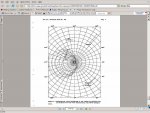Doug Riley
Platinum Member
- Joined
- Jan 11, 2004
- Messages
- 6,990
May I meddle with Greg's last paragraph?
The thrust to overcome the airframe's drag during a power-off glide is provided by the rotor. In such a glide, the rotor disk's leading edge is lower than its trailing edge. A vector component of the total rotor thrust is horizontal, pulling the gyro forward against airframe drag -- just like a helicopter. Bensen makes this point nicely in his gyroglider manual, including a side view of a gliding gyro clearly showing the forward tilt of the rotor relative to the horizon.
In a steady glide, the rotor's (tipped-forward) thrustline will be positioned relative to the aircraft's CG so as to create a net zero pitching moment on the frame. This may dictate that the rotor thrustline is ahead of, or behind, the CG, depending on the location of the airframe's center of drag relative to the CG. A low airframe center of drag will require rotor thrustline ahead of CG and vice versa.
Since the rotor must fly at the angle of attack it needs to hold the gyro up (no more and no less), the location of the CG relative to the rotor thrustline is accomplished by the flight stance of the airframe. For example, if the rotor thrustline needs to be ahead of the CG, then the CG will swing back relative to the rotor until this is so. The situation is a mirror image of the HTL/LTL balancing act.
The location of the prop's center relative to the CG will make a small difference in the aircraft's stance in a glide, even if the prop is idling or stopped. An idling prop becomes a drag brake at higher airspeeds. The location of the center of the prop thus will affect the location of the airframe's overall center of drag. The prop disk is just one of the draggy items on the frame. This is another reason why large displacements of the prop centerline away from the CG -- whether HTL or LTL -- are not a good idea: any moment about the CG created by the prop actually reverses direction when the power is chopped at higher airspeeds.
Everything cancels out once a steady state glide is reached, but the transition can be hairy and (I think) even dangerous in a poor enough design.
The thrust to overcome the airframe's drag during a power-off glide is provided by the rotor. In such a glide, the rotor disk's leading edge is lower than its trailing edge. A vector component of the total rotor thrust is horizontal, pulling the gyro forward against airframe drag -- just like a helicopter. Bensen makes this point nicely in his gyroglider manual, including a side view of a gliding gyro clearly showing the forward tilt of the rotor relative to the horizon.
In a steady glide, the rotor's (tipped-forward) thrustline will be positioned relative to the aircraft's CG so as to create a net zero pitching moment on the frame. This may dictate that the rotor thrustline is ahead of, or behind, the CG, depending on the location of the airframe's center of drag relative to the CG. A low airframe center of drag will require rotor thrustline ahead of CG and vice versa.
Since the rotor must fly at the angle of attack it needs to hold the gyro up (no more and no less), the location of the CG relative to the rotor thrustline is accomplished by the flight stance of the airframe. For example, if the rotor thrustline needs to be ahead of the CG, then the CG will swing back relative to the rotor until this is so. The situation is a mirror image of the HTL/LTL balancing act.
The location of the prop's center relative to the CG will make a small difference in the aircraft's stance in a glide, even if the prop is idling or stopped. An idling prop becomes a drag brake at higher airspeeds. The location of the center of the prop thus will affect the location of the airframe's overall center of drag. The prop disk is just one of the draggy items on the frame. This is another reason why large displacements of the prop centerline away from the CG -- whether HTL or LTL -- are not a good idea: any moment about the CG created by the prop actually reverses direction when the power is chopped at higher airspeeds.
Everything cancels out once a steady state glide is reached, but the transition can be hairy and (I think) even dangerous in a poor enough design.

